The following is from the latest issue of the Full Stop Quarterly. You can purchase the issue here or subscribe at our Patreon page.
In the seventeenth century, many classical artifacts were accessioned into the collections of the Vatican museums. When one marble statue arrived from a private collection held in an Italian villa, the curators saw the name ‘Sardanapallos’ in Greek letters carved across the chest of the figure. The curators noted that the statue depicted Sardanapalus, who was thought to have been the last king of Assyria, an area covering much of the modern-day Middle East, whose seventh century reign was synonymous with gluttony and excess.
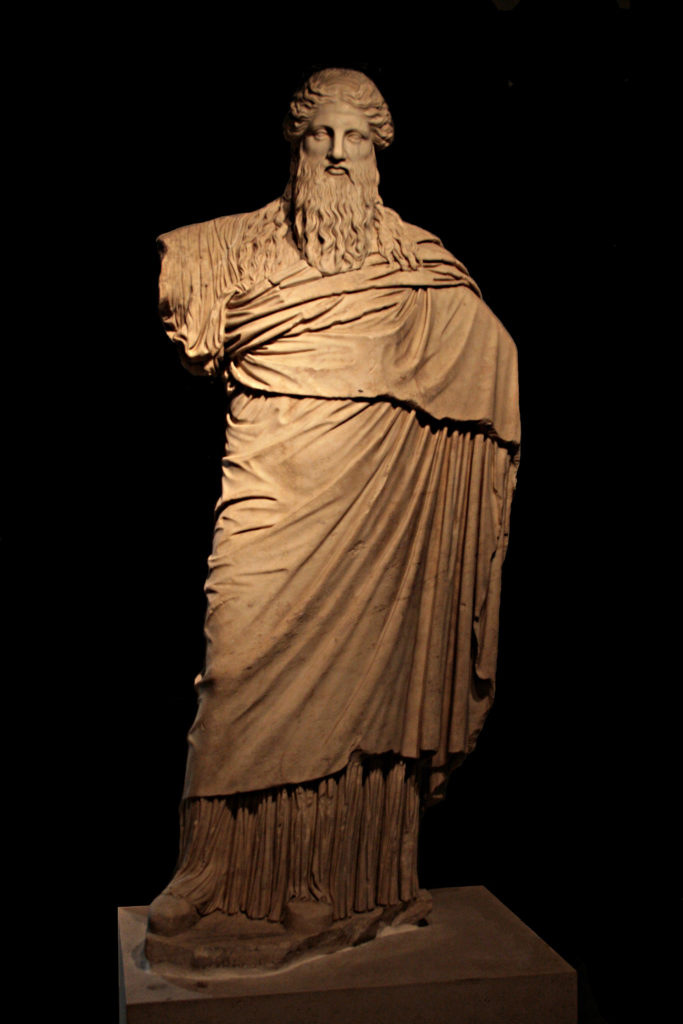
This attribution was criticized shortly thereafter. From the creation of the statue in antiquity to its status today in the twenty-first century, the Vatican Sardanapalus has been the subject of ongoing debate about the accuracy of its attribution. As soon as the statue was rediscovered and made viewable to the public, there was concern about whether the artifact truly depicted Sardanapalus—perhaps it instead depicted Dionysus? Accounts of the statue and comparisons to artifacts depicting Dionysus were made over the course of several hundred years. The matter was not quickly resolved, and the statue continued to be described by names that worked in opposition to each other, until finally in 1920 a dual name was settled on: Dionysus-Sardanapalus. The figure of Sardanapalus meanwhile accrued its own complex history, marked by influential and controversial representations by artists such as Eugène Delacroix and Jeff Wall. Eventually, questions arose as to whether Sardanapalus even existed. These mysterious fluctuations in meaning are the result of hundreds of years of interested and invested public critical inquiry, which have accumulated into a collective text perhaps best summed up by the statue’s permanently contradictory name, which is now the statue’s story.
J.J. Pollitt in Personal Styles in Greek Sculpture situates the moment in the sixteenth century when the public discussion and re-evaulation of antique artifacts was made possible. The possibility that Pollitt references was made through the creation of large collections of ancient artifacts put on view for the public. Though the ownership of these collections was concentrated under Papal authorities, it was thought that the ability to view these materials would provide enrichment to an interested public. And people did look at them; they walked up to and around, and otherwise observed artifacts of antiquity.
Interest grew through the nineteenth century, and Pollitt goes on to describe the impact:
The most far-reaching result of this new availability of information was that, although Rome continued to be a place of pilgrimage for lovers of ‘the antique,’ as the century progressed much of the most progressive and influential thought about ancient sculpture began to be produced by writers outside of Italy [. . .]. By the second half of the eighteenth century what had begun as a sophisticated mania in late-Renaissance Rome had become the subject of an international scholarly dialog (6).
The many handbooks and catalogues produced during the eighteenth and nineteenth centuries by scholars in and outside of Italy attest to that far-reaching public engagement.
Debates roiled on and the attribution of figures—either identifying important personages in carved stone and cast metal, or recognizing the particular styles of certain artists—produced their own monumental mosaic of suggestion, claim, and discussion. The statue of the Vatican Sardanapalus was included in this discussion.
German archaeologist Wolfgang Helbig, while walking through the Vatican museums around 1891 and describing all the antiquities on view to the public, decided that the statute of Sardanapalus was not actually a depiction of the ruler, and the reason for the appearance of this carved name was the work of “some private freak. Some bon vivant of the imperial epoch, interested in Sardanapalus.” Helbig theorized that due to Sardanapalus’s well-known and “refined luxury,” the previous owner “may have wanted to possess a portrait of [Sardanapalus] . . . and in order to give this title some documentary proof, the name was chiseled on the statue” (234).
Helbig’s reaction to the attribution made by the seventeenth-century curators at the Vatican museums brings to light complex issues in observation, documentation, and naming. The notions that what one observes may or may not be real, that what one documents may today be erroneous and later a truth, and that a name may carry the weight of context and meaning that exist before and after it, whether one in the present moment is familiar with the name already or not, provides momentum for the continued examination of material objects.
When the statue was accessioned into the museum collections, the curators may have decided to simply document what they saw, titling the object as it had already been titled by whomever had come into contact with it previously. This hermeneutic description could account for one aspect of the sculpture’s material life. Yet, to Helbig it acts as a twofold error: first in the original naming by the decision to carve it into the statue, and second in the inaccuracy in attribution when the statue was documented by curators. Helbig seems to suggest that this error was originally an ego-driven anachronism, one that was repeated by the Vatican curators. In perpetuating the misnaming of the Sardanapalus figure, historical coherence was lost from the life of the object.
When Helbig rejected the statue’s attribution, he was following suite with art historian Ennio Quirino Visconti who had already rejection the original attribution of the Vatican Sardanapalus.
Visconti’s own observations, recorded in his 1818 catalog Musée Pie-Clémentin, suggest that the naming of the statue occurred during the ancient period, whether it was an intentional or accidental effort:
I believe that before giving the statue a name, according to the inscription engraved on it, it would be necessary to examine if the figure does not represent a character that might be a subject not very compatible with this epigraph, and then we will have to look at this name of CAPΔANAΠAΛΛOC as an ancient error, or as an ancient sham. The subject is itself now very well known to us, and the sculpture itself shows that it is nothing other than the old or bearded Bacchus, fairly common in ancient mythology (294–295 translation from French by the author).
Visconti here contends that the sculpture actually represents Bacchus, or Dionysus, the Ancient Greek god associated with winemaking and ritual ecstasy. Unlike Hebig, Visconti offers that the carved name of ‘Sardanapallos’ could also have appeared due to an error in judgement; a mistake.
The act of naming does not require the truth or falsity of intention, but holds only what can be known or conceptualized in the current moment. If we can assume the sculpture when created was meant to be Dionysus, but later became known as Sardanapalus, and then eventually again as Dionysus, then this description of ‘Sardanapallos’—whether a mistake or deception—perpetuates an attribution that functions dualistically. The image of Dionysus and the image of Sardanapalus, over time, became an antagonism held in one figure: the Vatican Sardanapalus.
Visconti’s discussion of the Vatican Sardanapalus rejects the attribution made by the German archaeologist and art historian Johann Joachim Winckelmann years earlier. Though Winckelmann’s achievements during the late eighteenth century in archeology and art history were influential, his descriptions of known antique sculpture were more concerned with stylistic epochs and aesthetic analysis than the accurate attribution of figures (Pollitt 7–8). Visconti’s rejection of Winckelmann’s attribution is based on the comparison of other known depictions of Dionysus, including the age of the figure depicted, the hair, and whether the gesture of the body could indicate the absence of a thyrsus—a fennel staff associated with Dionysus. Visconti also attempts to date when the word ‘Sardanapallos’ was carved on the sculpture by comparing spellings of the name over time and across regions that used the Greek language.
As part of the larger scholarly movement towards re-evaluating figures—which coincided with public access to these sculptures—Visconti situates the public as an observer not only of the artifacts, but of the debate. He then invites the public in: “I will submit [the attribution] to the readers for judgment, after I have put them in a position to observe the statue with all the details which belong to it” (290). Visconti presents his observations together with the sculptural artifact as relevant material for critical inquiry. The public is seen as a necessary participant to this debate, showing that scholarly pursuits interested in producing new ideas could be based in community effort.
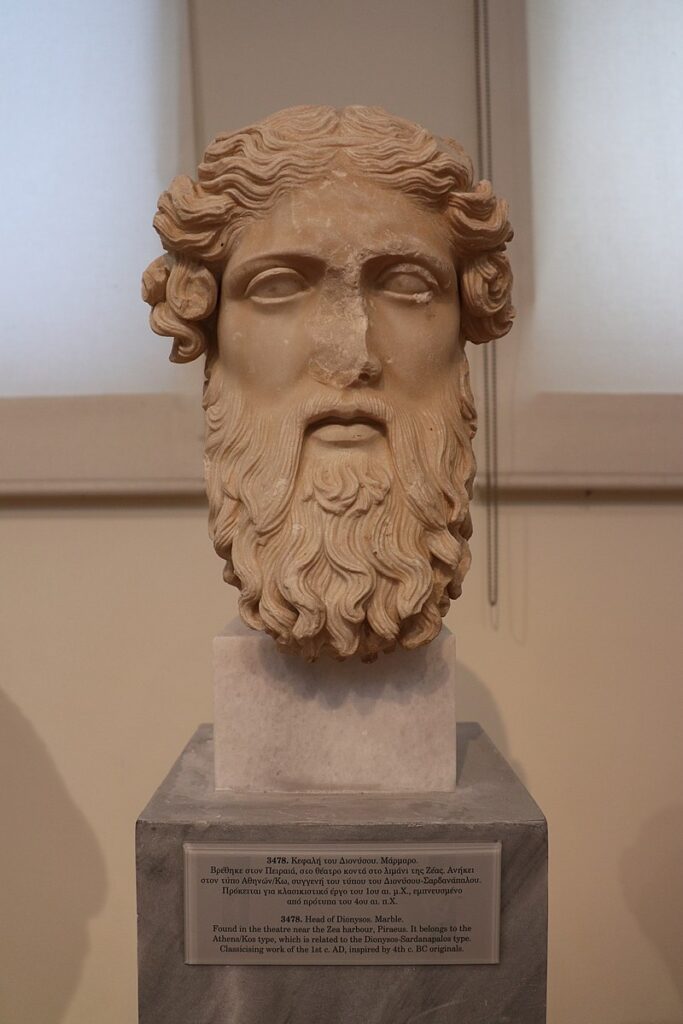
Photo by Georgia E. Koronaios
Throughout the nineteenth and the early twentieth centuries, scholars remained critical of the Sardanapalus attribution. Alongside new findings of similar sculptures and fragments, they continued to debate whether the Sardanapalus was indeed a type of classical statute or if the statue type actually represented that of Dionysus. The responses to these questions address representations of Sardanapalus through the examination of the body, where the coincidental employment of repetition remains as controversial as the statue itself. Two articles in the English language that show the impact of the Vatican attribution on new artifactual findings have the same name: ‘The so-called Sardanapalus,’ yet these articles were published by two different authors, fifteen years apart.
Katharine McDowell in 1904, notes: “In the British Museum example the left foot is so much in keeping with the statute, and its absence so much felt in the Vatican replica, that it probably belongs to the original. It is interesting to note that this feature occurs in all the works enumerated here as akin to the Dionysos” (258).
Bernard Ashmole in 1919–1921 points out: “The less general view, that the ‘Sardanapalus’ was a work of the Pheidian circle, is seriously weakened, if not disproved, by the discovery of the fine Peiraeus head [. . .] almost certainly representing Dionysos” (85). Clearly, both authors take issue with the original attribution of the Sardanapalus type.
This repeated naming of two separate research results activates the uncanniness present in the subject of the statue itself. McDowell and Ashmole go on to describe the statue’s body.
McDowell: “[. . .] treatment of the chiton, especially in its fall over the left foot [. . .]” and “[. . .] the lips rather full, serene, and passionless [. . .]” (257).
And Ashmole: “[. . .] the left food projects from the drapery” and “The left foot again projects from the drapery” (84, 85).
The figure is doubled and multiplied. The left foot projects from the chiton in multiple variations of potential meaning. Each name—Sardanapalus or Dionysus—is described as a mirror of itself and the opposite, both in a reflected multiplicity that extends indefinitely.
In a section on Greek sculpture in the American Journal of Archaeology in 1920, William N. Bates summarizes thus:
Dionysus-Sardanapalus.—At the December (1915) meeting of the Berlin Archaeological Society, [. . .] W. Amelung spoke on the bearded seated figure in the Vatican commonly known as Sardanapalus. A replica found in Crete, with an ivy crown and traces of a thyrsus, proves that the type is a Dionysus (380).
The statue was renamed, or named twice: the Dionysus-Sardanapalus. This act of re-naming connects both names within one dialectical object. Neither version exists without its opposite, and the fluctuation between the two creates an activated third space of process, inertia, and possibility, that functions only by variation and movement between the forms of knowledge categorized by naming. The statue embodies this unstable relationship between history, narrative, and artifact.
On the one hand, we see Dionysus, on the other, Sardanapalus.
Modern artistic representations of Sardanapalus are just as uncanny as the statue, representing the body of Sardanapalus in double or not at all. A painting by Eugène Delacroix from 1827 titled “La Mort de Sardanapale” depicts the end of the reign of Sardanapalus, the ruler watching as those around him are murdered. Elizabeth Fraser, in a 2003 essay for the French Historical Studies journal, “Delacroix’s Sardanapalus: The Life and Death of the Royal Body,” argues that the depiction of a royal body that resides outside of what the public would typically understand as a royal scene—Sardanapalus in private rooms—subverts the authority of that system and causes the public to question its own role in daily life.
The exhibition of Delacroix’s painting does much to provide the public with a subversive, dualistic narrative by depicting themes within a context that prior to that moment could not account for them—public and private; inside and outside—in the end, complicating the image of the Assyrian King.
Fraser also suggests that Delacroix’s equally informal approach to the application of visual standards in painting during this period perpetuated an uneasiness in the observer while the painting was in view. Yet, if we intend to expand our field of vision, we must ask questions and attempt to uncover and account for changes in the things we know, even if these changes might disrupt our ontology.
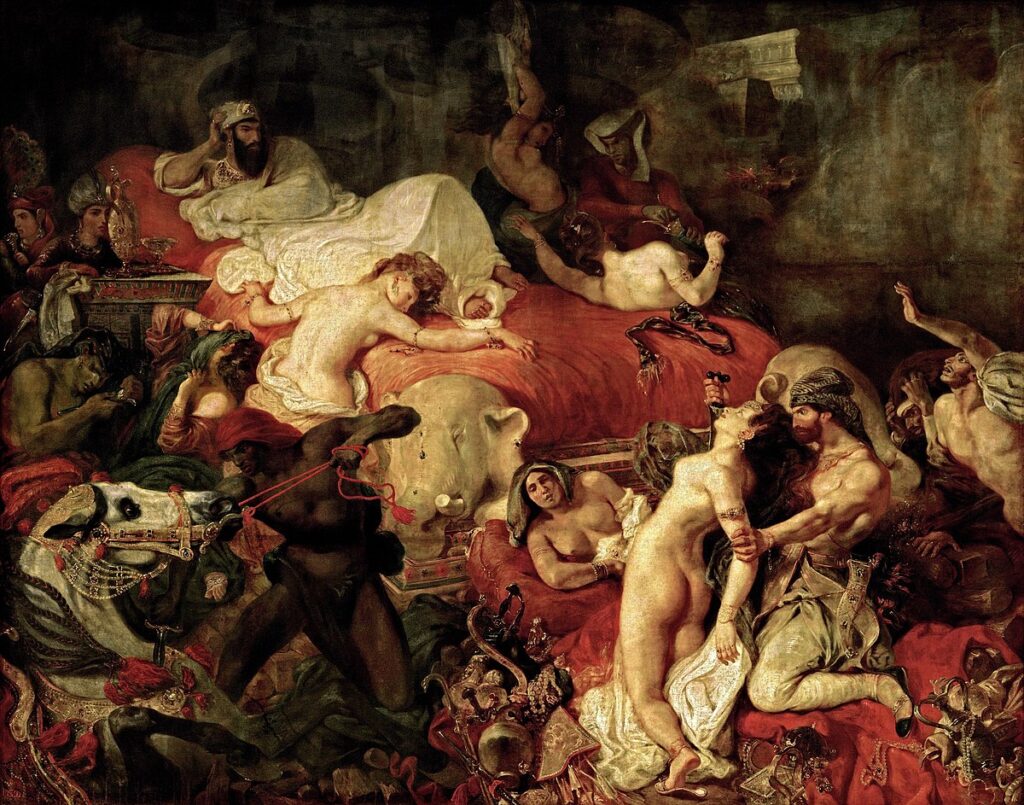
A description of this painting made by the art historian Lee Johnson from the Metropolitan Museum of Art’s Delacroix exhibition catalogue from 1991, suggests that in the painting the entourage surrounding Sardanapalus was murdered by his very own command. Johnson says that Delacroix, responding to Lord Byron’s play “Sardanapalus,” meant “to include a general slaughter by the Assyrian king of his entire retinue [. . .]” (16). Does the observation made by Lee change the way we see the painting? Is Sardanapalus’ death an accurate historical depiction of a ruler that will die, or is it a metaphorical one, where Sardanapalus watches over the destruction of his grand legacy, that which comes from his own decision?
To our understanding of who Sardanapalus is—that which constitutes both the historical narrative of the ruler and the cultural references of a personage—we must continue to add a variety of possible depictions, in order to continue to investigate the meaning and significance of Sardanapalus to human knowledge. Sardanapalus may remain a ruler, but our stories and variable depictions evoke a meaning beyond a historical narrative.
Delacroix made a replica of the painting in 1844, doubling the representation, doubling the name, doubling the body. Both paintings were given the same name: “La Mort de Sardanapale” and, like Ashmole’s and McDowell’s articles, were created about fifteen years apart.
Is the painting a replica or an original? Is it a copy?
Fraser, referencing Ernst H. Kantorowicz’s 1957 book The King’s Two Bodies, continues describing the body of Sardanapalus:
Because of the potential political crisis caused by the monarch’s death, an elaborate theory of the king’s two bodies evolved, according to which the monarch had both an earthly, mortal body and a divine body that lived beyond his death. [. . .] The notion of the divine unity of kingship was meant to over-shadow the conceptual difficulty of one king’s body being substituted as successor for the other, deceased one (336).
As Fraser suggests, Sardanapalus has two kingly bodies—one earthly and one divine. Yet due to the repeated, mirrored depictions of Sardanapalus, in the cultural artifacts of sculpture, scholarship, and painting, we can read the bodies as varied, multiple, and non-linear messages about the ruler.
Delacroix’s first painting may depict the continued power of tyranny, and the second painting, may depict the second body’s lack of prescient moral codes. One painting may be a beginning, the other an end; both paintings may end and begin again. At the same time, they have one name and they have two. If we apply this theory to the multitudinous depictions of Sardanapalus, we see that all contain a successor, many bodies that live on a milieu of objects in a reign beyond death.
In the depiction of Sardanapalus both left foot and right foot protrude from the drapery.
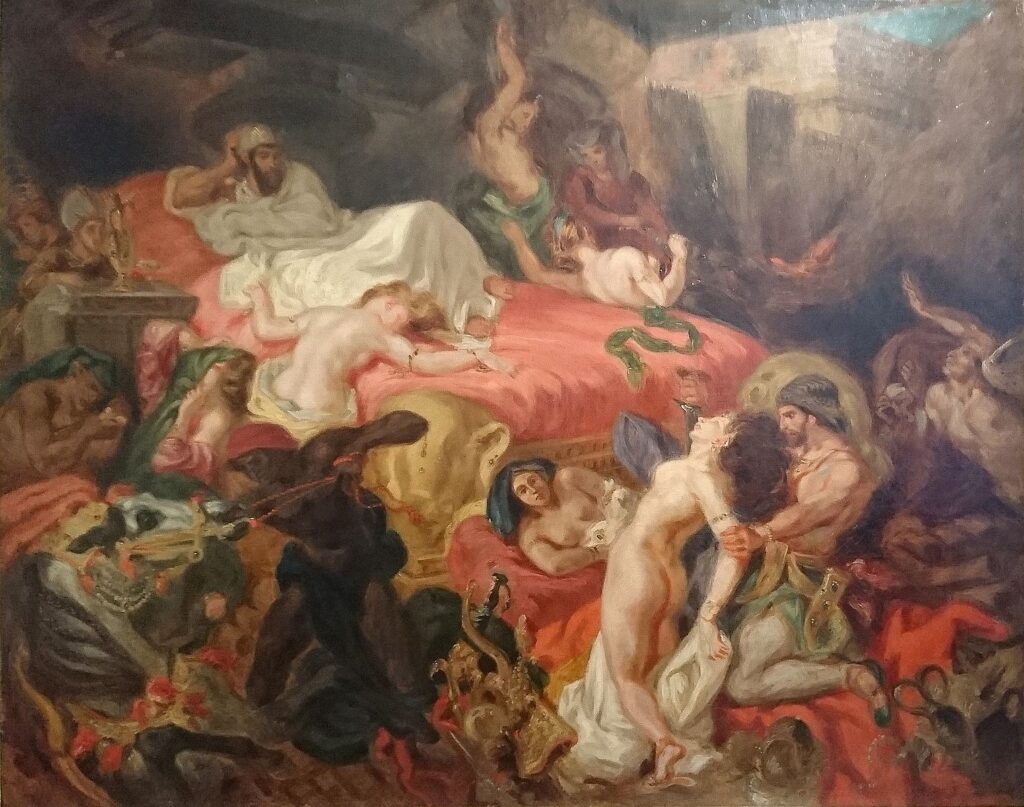
The second Delacroix Sardanapalus painting is exhibited in an installation at the Philadelphia Museum of Art, where it hangs above an empty red and gold plush sofa referencing the luxury and excess of a reign without the body of its ruler. The sofa was made in France during the mid-nineteenth century; though its attribution is unknown, it is one of a pair.
In observing the juxtaposition of these objects, the curators mark the sofa with a name it did not previously have—Sardanapalus. The sofa suggests the complexity of a body, one that was there but is no longer. With the addition of a second sofa, questions about Sardanapalus multiply. The sofas may act as the containers of royal bodies, one earthly, one divine. The sofas remind us of auxiliary bodies—one for McDowell and one for Ashmole; for Visconti and Helbig, for Dionysus and Sardanapalus.
Jeff Wall’s intentional photographic response to the Delacroix painting called “The Destroyed Room” from 1978, represents the aftermath of the death of Sardanapalus, again without the body.
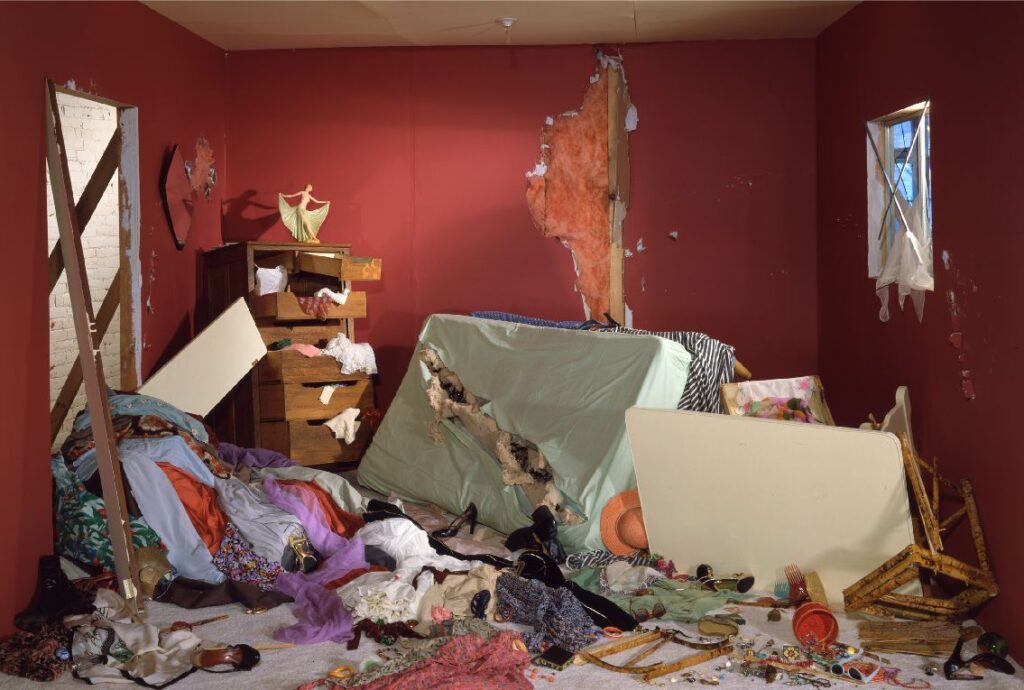
In an interview from The Believer, Wall says of the work: “I think of those pictures as extremely mannerist, very literary. They probably provoke referentiality, although they don’t necessarily impose it. Take ‘The Destroyed Room’ as an example. If you didn’t know who Delacroix was, who cares, really; it doesn’t really matter. [. . .] I’m not trying to create a complicated thing for only a certain kind of person to know. Anyone can know.”
Though the public does not need to explicitly know Jeff Wall’s referent to view and scrutinize his photographic transparencies, there is a very clear relationship between the two. Each piece shares a name. The work depicts the same subject matter. “The Destroyed Room” does embody Delacroix’s Sardanapalus, but without the body. If Delacroix’s painting shows the difference between the public and private life of a ruler, Wall showcases the material consequences of action; the end of history; the end of narrative.
Jeff Wall is quoted by the Tate Modern noting a detail of “The Destroyed Room”: “Through the door you can see that it’s only a set held up by supports, that this is not a real space, this is no-one’s house.” If the room is shown to be false, so is the story. The intentional deception turns history to mythology, where the figure of Sardanapalus, at once in the foreground, continues to recede. We no longer know what was there in the first place, if the body ever existed. If we excavated this space, we would find the deception, we would find an archive.
Sardanapalus as a figure seems to fluctuate between vanishing and appearing.
The last king of Assyria, Sardanapalus, his rule and reputation for excess is now believed by contemporary historians itself to be a myth. References to Sardanapalus exist in Greek and Roman literature, but the name does not exist in known Assyrian documents and is not used in contemporary scholarship. These representations lend themselves to the uncanny juxtaposition of names, and the complicated history of representation that scholarship, in its necessarily unstable state, provides.
Looking across the centuries, one wonders if Sardanapalus ever existed, and if so how. The story of Sardanapalus can be read as the history of an error of naming or a mythological story that acts as a discussion of ethical leadership, tyranny, and human indecency. How we got here could be through a poor translation, or a biased description from the Greek period. In a way, it is all of these and none, and there is a possibility that in the future additional artifacts will tell us more. We may read them differently than we do today; or we may be gone, all the birds, bees, plants, and language extinct from what we knew as culture and landscape.
Jaime Groetsema is a bibliothecary living in Colorado. Her doppelgänger is a pharmacist living in Florida.
This post may contain affiliate links.








